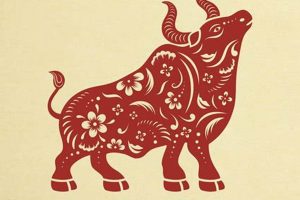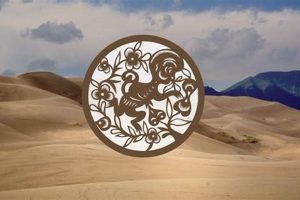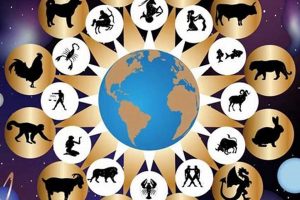This ancient practice utilizes a complex system based on the lunisolar calendar, incorporating animal signs, elements, and other factors to provide insights into personality, relationships, and future prospects. A typical consultation might involve examining an individual’s birth chart, which is constructed based on their birth year, month, day, and hour, to reveal potential strengths, weaknesses, and life paths.
For centuries, this form of divination has been an integral part of Chinese culture, offering guidance and self-awareness. Its enduring popularity stems from its potential to provide clarity and understanding of one’s circumstances and offer perspectives on navigating life’s complexities. Understanding the interplay of these astrological influences can empower individuals to make informed decisions and cultivate harmonious relationships.
Further exploration of specific elements like the twelve animal signs, their associated characteristics, and the role of elemental influences can provide a deeper understanding of this rich and intricate tradition. This framework allows for a detailed analysis of individual destinies and the dynamic interactions within interpersonal connections.
Tips for Utilizing Astrological Insights
These suggestions aim to facilitate a more meaningful engagement with astrological interpretations. They offer practical guidance for applying these insights to enhance self-awareness and navigate life’s complexities.
Tip 1: Consult Qualified Practitioners: Seeking guidance from experienced practitioners ensures the accuracy and depth of interpretations. Their expertise can unlock the full potential of a personalized consultation.
Tip 2: Focus on Self-Reflection: Astrological insights serve as tools for introspection, not definitive pronouncements. Use interpretations as prompts to reflect on personal strengths and areas for growth.
Tip 3: Integrate, Don’t Dictate: Allow interpretations to inform, not dictate, decisions. Integrate these insights with personal judgment and critical thinking.
Tip 4: Embrace Nuance and Complexity: Recognize the intricate interplay of astrological factors. Avoid oversimplification and embrace the multifaceted nature of interpretations.
Tip 5: Consider Long-Term Trends: While immediate influences are relevant, focus on broader trends and cycles to gain a more comprehensive perspective on personal development.
Tip 6: Cultivate Open-Mindedness: Approach interpretations with an open mind and a willingness to explore new perspectives. This receptive attitude enhances the potential for self-discovery.
Tip 7: Respect Cultural Context: Appreciate the cultural heritage and traditions that inform these practices. Respectful engagement enriches the understanding and application of insights.
By incorporating these suggestions, individuals can gain a richer understanding of themselves and their potential. Astrological insights, when approached thoughtfully, can become valuable tools for personal growth and navigating life’s journey.
These tips pave the way for a deeper exploration of individual potential and the dynamic forces that shape one’s destiny.
1. Birth Chart Analysis
Birth chart analysis forms the cornerstone of Chinese astrological readings. This intricate process decodes individual destinies by mapping the positions of celestial bodies at the precise moment of birth. Understanding this analysis is crucial for unlocking the personalized insights offered by this ancient practice.
- The Four Pillars of Destiny:
This foundational concept divides the birth chart into four components: year, month, day, and hour. Each pillar represents a specific aspect of life, such as ancestral influence (year), social environment (month), personal characteristics (day), and inner self (hour). These pillars interact to create a complex tapestry reflecting an individual’s unique energetic blueprint. For example, someone born in the year of the Dragon, month of the Tiger, day of the Monkey, and hour of the Rat might exhibit a dynamic blend of leadership, ambition, wit, and resourcefulness.
- The Ten Heavenly Stems and Twelve Earthly Branches:
These cyclical systems further refine the four pillars. The ten stems represent elemental energies, while the twelve branches correspond to the animal signs. Their combination creates 60 unique pairings, each associated with specific characteristics. This intricate interplay adds depth and nuance to personality interpretations. For instance, a Wood Dragon differs significantly from a Fire Dragon due to the varying elemental influences.
- Elemental Interactions:
The five elementswood, fire, earth, metal, and waterinteract dynamically, creating cycles of creation and destruction. Analyzing these interactions within a birth chart reveals potential strengths, weaknesses, and areas of harmony or conflict. An individual with strong fire and metal elements might exhibit both creativity and resilience but also experience internal tension due to their conflicting nature.
- Predictive Applications:
Birth chart analysis not only illuminates inherent traits but also informs predictions about future trends. By examining the interplay of elements and animal signs over time, practitioners can offer insights into potential challenges and opportunities in various life areas, such as career, relationships, and health. This predictive aspect allows individuals to anticipate and navigate life’s transitions with greater awareness.
By synthesizing these facets, birth chart analysis provides a comprehensive and personalized lens through which to understand individual destinies within the framework of Chinese astrology. It allows for a deeper exploration of one’s potential, challenges, and the intricate interplay of cosmic influences that shape life’s journey.
2. Twelve Animal Signs
The twelve animal signsRat, Ox, Tiger, Rabbit, Dragon, Snake, Horse, Goat, Monkey, Rooster, Dog, and Pigform a fundamental pillar within Chinese astrology. These signs are not merely symbolic representations but integral components of a complex system used to interpret personality traits, predict compatibility, and forecast future trends. Understanding their significance is crucial for navigating the intricacies of a Chinese astrological reading.
- Yearly Cycles and Personality Archetypes:
Each animal governs a specific year in a twelve-year cycle, imbuing individuals born under its influence with distinct characteristics. For example, those born in the year of the Dragon are often perceived as charismatic and ambitious, while those born in the year of the Rabbit are seen as gentle and artistic. These archetypes provide a framework for understanding behavioral patterns and potential strengths and weaknesses.
- Elemental Influences and Nuance:
The animal signs interact with the five elementswood, fire, earth, metal, and wateradding further layers of complexity to personality interpretations. A Fire Dragon exhibits different traits than a Wood Dragon, showcasing the dynamic interplay between these forces. This integration of elemental influences enhances the depth and accuracy of astrological readings.
- Interpersonal Compatibility and Relationship Dynamics:
The animal signs play a crucial role in assessing compatibility between individuals. Certain signs are considered more harmonious pairings, while others may present challenges. Understanding these dynamics can offer valuable insights into relationship potential and strategies for navigating interpersonal interactions. For example, a Rat and an Ox might face communication hurdles due to their differing approaches, while a Dragon and a Monkey could find stimulating synergy in their shared dynamism.
- Predictive Applications and Life Path Guidance:
Beyond personality analysis and compatibility assessments, the twelve animal signs contribute to predictive techniques within Chinese astrology. By analyzing the yearly influences and their interactions with an individual’s birth chart, practitioners can anticipate potential challenges and opportunities in various life aspects. This predictive element provides a roadmap for navigating future transitions and making informed decisions aligned with one’s astrological profile.
The twelve animal signs are not isolated symbols but interwoven threads in the rich tapestry of Chinese astrology. Their interplay with other astrological components offers a nuanced understanding of individual destinies and provides a framework for navigating life’s complexities. By integrating these insights, individuals can gain valuable self-awareness and cultivate a deeper understanding of their place within the interconnected web of existence.
3. Five Elements Influence
The Five ElementsWood, Fire, Earth, Metal, and Waterare not merely symbolic representations but integral components of Chinese astrology, deeply interwoven with its interpretive and predictive aspects. Their influence permeates all facets of a reading, shaping personality traits, influencing relationship dynamics, and informing predictions about future trends. Understanding their intricate interplay is essential for grasping the nuances and complexities of this ancient practice. Each element embodies distinct characteristics: Wood signifies growth and creativity; Fire represents passion and energy; Earth symbolizes stability and practicality; Metal denotes focus and discipline; and Water embodies adaptability and intuition. These elemental attributes interact dynamically, creating cycles of creation, destruction, and control, influencing the overall interpretation of an individual’s astrological profile. For instance, a Wood person might exhibit strong leadership qualities coupled with artistic inclinations, while a Metal person might demonstrate a preference for structure and precision.
The Five Elements also play a crucial role in assessing compatibility between individuals. Certain elemental combinations are considered more harmonious, promoting synergistic relationships, while others may present challenges requiring conscious effort to navigate. For example, Wood and Fire can create a dynamic and supportive partnership, whereas Water and Fire might experience more friction due to their contrasting natures. In predictive applications, the cyclical nature of the Five Elements provides insights into auspicious and challenging periods. By analyzing the flow of elemental energies within a specific timeframe, practitioners can offer guidance on navigating potential obstacles and maximizing opportunities. For instance, a year dominated by Metal energy might be favorable for initiating new ventures and focusing on long-term goals, while a year influenced by Water energy might emphasize adaptability and emotional intelligence.
Integrating the Five Elements into Chinese astrology readings provides a multi-dimensional understanding of individual destinies. Their influence extends beyond simple categorization, offering a nuanced perspective on the complexities of human experience. Recognizing the cyclical nature of these elements and their intricate interactions is essential for unlocking the full potential of a Chinese astrology reading and applying its insights to navigate life’s journey with greater awareness and understanding. This understanding enhances the practical application of astrological wisdom, empowering individuals to make informed decisions aligned with their unique elemental profile and the prevailing cosmic influences.
4. Yin and Yang Balance
The concept of Yin and Yang, representing the duality and interconnectedness of opposing forces, is fundamental to understanding Chinese astrology. This principle permeates all aspects of a reading, influencing interpretations of personality, relationships, and future predictions. Achieving balance between these complementary forces is considered crucial for overall well-being and harmony.
- Personality Traits and Elemental Influences:
Yin and Yang manifest in individual personalities through varying degrees of introversion and extroversion, passivity and assertiveness, and emotional expression. These qualities are further nuanced by the Five Elements, creating complex and individualized profiles. For example, a Yin Water person might be deeply intuitive and introspective, while a Yang Fire person could be outwardly passionate and energetic. Recognizing these inherent tendencies allows for greater self-awareness and facilitates personal growth.
- Relationship Dynamics and Compatibility:
Yin and Yang play a crucial role in assessing relationship compatibility. Balance between these energies is often seen as ideal, fostering mutual support and understanding. However, relationships between two strongly Yin or two strongly Yang individuals can present unique challenges. For instance, a relationship between a Yin Earth person and a Yang Wood person could thrive due to their complementary natures, while two Yang Fire individuals might experience power struggles. Understanding these dynamics helps navigate interpersonal relationships with greater awareness.
- Predictive Applications and Life Cycle Fluctuations:
The ebb and flow of Yin and Yang influence life cycles and events. Chinese astrology utilizes these principles to anticipate periods of expansion and contraction, activity and rest, and external focus versus introspection. For instance, a period dominated by Yang energy might be conducive to taking action and pursuing ambitious goals, while a period of Yin influence could be better suited for reflection and consolidation. This understanding allows individuals to align their actions with prevailing cosmic energies.
- Practical Applications for Achieving Harmony:
Chinese astrology offers guidance on achieving Yin and Yang balance through lifestyle adjustments, such as incorporating practices like meditation, Qigong, or Feng Shui. These methods aim to harmonize internal energies and create a more balanced flow between Yin and Yang, fostering overall well-being and facilitating a deeper connection with one’s astrological profile. This practical application extends beyond theoretical understanding, empowering individuals to actively cultivate harmony in their lives.
Integrating the principles of Yin and Yang provides a deeper understanding of the interconnectedness and dynamic interplay of forces within Chinese astrology. This framework enhances the accuracy and depth of interpretations, empowering individuals to navigate life’s complexities with greater awareness and achieve a more harmonious existence aligned with their inherent energetic blueprint. By recognizing and balancing these opposing forces, one can unlock the full potential of a Chinese astrology reading and gain valuable insights into personal growth and self-cultivation.
5. Predictive Techniques
Predictive techniques constitute a significant component of Chinese astrological readings, extending beyond personality analysis to offer insights into future trends and potential life paths. These techniques, rooted in the intricate interplay of Yin and Yang, the Five Elements, and the cyclical nature of time, provide a framework for anticipating challenges and opportunities, allowing individuals to navigate life’s transitions with greater awareness. Cause and effect within this system are not viewed as deterministic but rather as a complex web of interacting influences. For example, an individual’s birth chart might indicate a predisposition towards certain career paths, but external factors and personal choices ultimately shape the outcome. Similarly, while astrological predictions might suggest potential relationship challenges during specific periods, understanding these influences can empower individuals to proactively address and mitigate potential conflicts.
Several specific predictive methods exist within Chinese astrology, each with unique applications. Annual predictions, based on the interplay of an individual’s birth chart with the prevailing yearly energies, offer insights into overall trends and potential challenges or opportunities in various life areas. Techniques like BaZi (Four Pillars of Destiny) and Zi Wei Dou Shu (Purple Star Astrology) provide more granular predictions, analyzing specific time periods and life events. For instance, BaZi might be used to determine auspicious dates for important events like weddings or business ventures, while Zi Wei Dou Shu can offer deeper insights into career trajectories and relationship dynamics. Real-life examples abound, such as individuals using these techniques to make informed decisions about career changes, relocation, or relationship commitments. While the efficacy of these methods remains a subject of debate, their enduring popularity speaks to their perceived value in providing guidance and fostering a sense of agency in navigating life’s uncertainties.
Understanding the role of predictive techniques in Chinese astrological readings provides a more complete picture of this complex practice. While personality analysis offers valuable self-awareness, the predictive element adds a dynamic dimension, empowering individuals to anticipate and prepare for future transitions. Integrating these insights requires discernment and critical thinking, recognizing that astrological predictions are not deterministic pronouncements but rather tools for navigating life’s complexities with greater awareness and intentionality. The inherent limitations of predictive methods, such as the potential for misinterpretation or overreliance on astrological guidance, warrant consideration. Ultimately, the practical significance of these techniques lies in their potential to empower informed decision-making and foster a more proactive approach to shaping one’s destiny.
Frequently Asked Questions
This section addresses common inquiries regarding interpretations, providing clarity and dispelling misconceptions. Understanding these points enhances engagement with this complex practice.
Question 1: How does one determine their Chinese zodiac animal?
The animal sign is determined by the year of birth, based on the Chinese lunisolar calendar. Online resources and conversion charts readily provide this information. It’s important to note that the Chinese New Year typically falls between late January and February, so individuals born in these months should verify the corresponding year in the Chinese calendar.
Question 2: Do animal signs definitively determine personality?
Animal signs offer archetypal representations of personality tendencies, not absolute determinants. Numerous other factors, including the month, day, and hour of birth, as well as individual life experiences, contribute to personality development.
Question 3: How accurate are predictions based on readings?
Predictions should be viewed as potential trends, not guaranteed outcomes. They offer insights into possible challenges and opportunities, empowering individuals to make informed decisions. Free will and external circumstances play significant roles in shaping individual destinies.
Question 4: Can compatibility between animal signs be definitively assessed?
Compatibility assessments offer general guidelines, not absolute pronouncements. While certain animal sign combinations might present inherent challenges, successful relationships depend on mutual understanding, communication, and shared values.
Question 5: What distinguishes Chinese astrology from Western astrology?
Key distinctions include the use of the lunisolar calendar, emphasis on animal signs and elemental influences, and specific predictive techniques like the Four Pillars of Destiny. While both systems seek to understand human nature and destiny, their methodologies and interpretive frameworks differ significantly.
Question 6: How can one benefit from a professional consultation?
Consultations with qualified practitioners provide personalized insights based on a comprehensive analysis of one’s birth chart. This guidance can foster self-awareness, enhance decision-making, and provide a deeper understanding of life’s trajectory.
Careful consideration of these points facilitates a more nuanced and informed approach to utilizing astrological insights for personal growth and understanding.
Further exploration of specific applications, such as relationship analysis or career guidance, can provide additional insights and practical applications of these principles.
Conclusion
Exploration of this ancient practice reveals a complex system interwoven with cultural significance and philosophical depth. From the interplay of animal signs and elements to the predictive techniques rooted in cyclical time, analysis illuminates a path toward self-discovery and informed decision-making. Key components, including birth chart analysis, the influence of Yin and Yang, and the application of predictive methods, offer a framework for understanding individual destinies within a broader cosmological context. Addressing common inquiries clarifies potential misconceptions, fostering a more nuanced appreciation for the practice’s intricacies.
The enduring relevance of this tradition lies in its potential to empower individuals to navigate life’s complexities with greater awareness. Whether seeking deeper self-understanding, exploring relationship dynamics, or anticipating future trends, offers a unique lens through which to interpret the human experience. Further investigation and thoughtful application of these principles can unlock valuable insights and foster a more profound connection with one’s journey through life.







